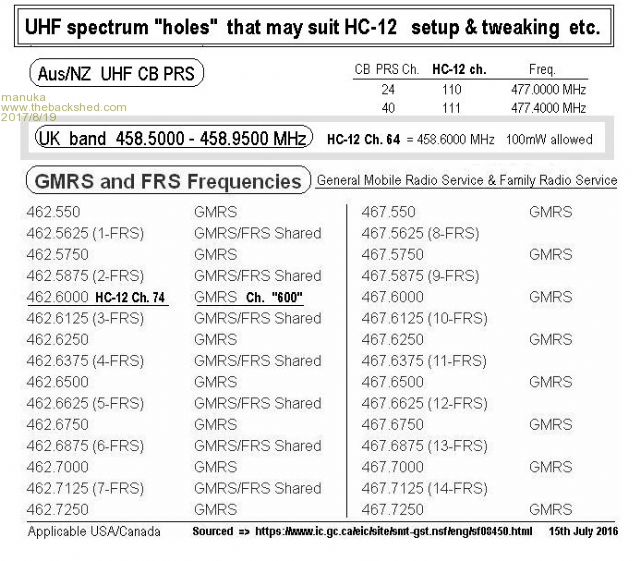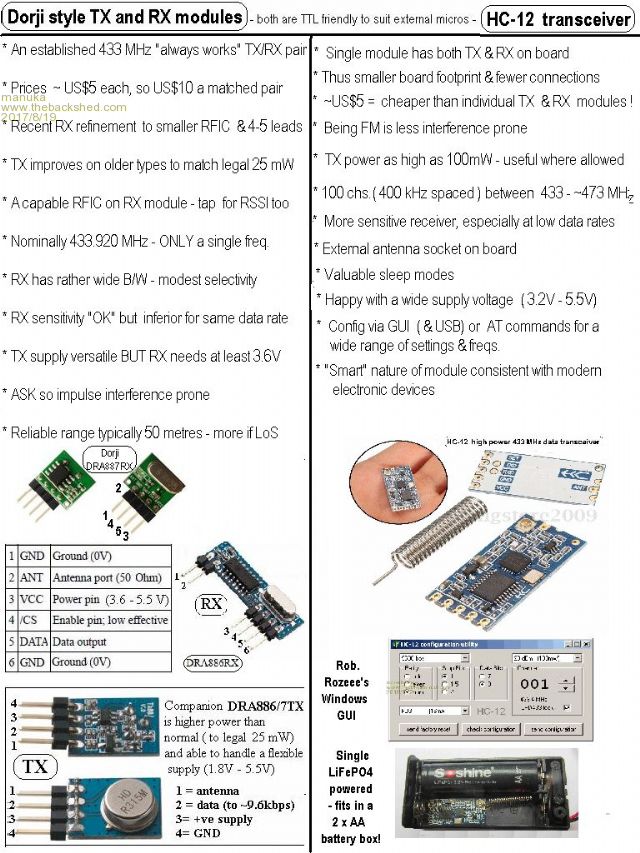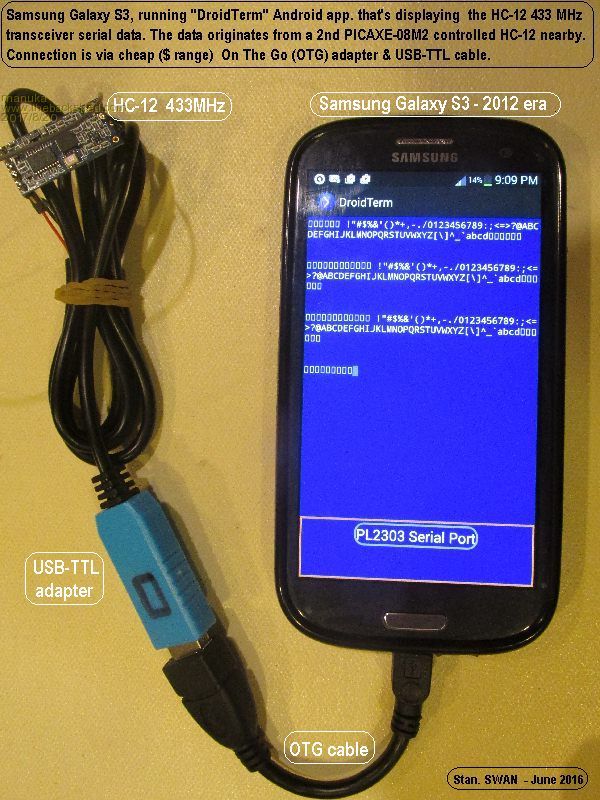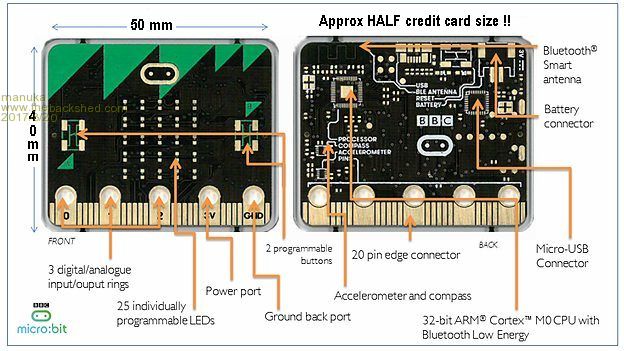
|

|
Forum Index : Microcontroller and PC projects : HC-12 Wireless Serial Module
| Author | Message | ||||
| Alastair Senior Member Joined: 03/04/2017 Location: AustraliaPosts: 161 |
Rob, I am a recent newbie in the MM community and the back shed. I have restarted electronics fiddling after many years of being too busy. Now retired I am updating my skills, knowledge and attitudes to the modern electronics scene. I have just added a couple of HC-12 modules to link to my prototype MM+ solar HW monitor and control module. Thank you for providing the HC-12 configuration module which makes another job on my list redundant. It made the implementation very simple. I am now building a MM+ BP based unit which will eventually listen in to a number of modules around the house by cycling through a range of channels and downloading data. Thanks Cheers, Alastair |
||||
Grogster Admin Group Joined: 31/12/2012 Location: New ZealandPosts: 9082 |
Have to agree 100% with that comment.  I have used more then 100 HC-12's in the last year or so on a couple of projects, and Rob's utility for programming these is fantastic. Once setup the way you want, you can just plug in the next one, and click SEND CONFIGURATION - done.  This perhaps does not sound like much help, but you'd be surprised how much time this saves over having to type the commands into each and every module. Smoke makes things work. When the smoke gets out, it stops! |
||||
| Alastair Senior Member Joined: 03/04/2017 Location: AustraliaPosts: 161 |
Grogster, Even though I was only using a pair at this stage, I was changing multiple parameters to get a feeling for power, distance, interference, errors etc. This is my first use of these little cheapies and I was very suspicious of their performance. I have tended to hardwire things in the past but am now sold on the convenience of the HC-12. Have you encountered any problems with interference in & out with other rf devices? This aspect worries me somewhat with the vast number of wireless devices we have around us now. I connected a long piece of wire to the input of my cro and turned the FFT on. There are certainly lots of signals around the place! cheers Cheers, Alastair |
||||
| manuka Newbie Joined: 18/12/2006 Location: New ZealandPosts: 19 |
Agreed ! As HC-12 cover >100 "channels" at 400kHz spacing a further benefit is that they may feasibly suit use on other frequency spots, some with higher power.  The legality of this should of course be verified, but reception (at least) on several UHF CB channels is possible - see attached summary. |
||||
| manuka Newbie Joined: 18/12/2006 Location: New ZealandPosts: 19 |
 Aside from NZ/Aus UHF "PRS", several UK & USA spectrum slots match up too. At the very least a cheapie UHF CB set can be used to check if your HC-12 transmitter is actually working,along with it's range,duty cycle & antenna/elevation benefits etc. Stan. |
||||
| Alastair Senior Member Joined: 03/04/2017 Location: AustraliaPosts: 161 |
Stan, Very interesting. I will digest this. I have a near neighbour who has a big aerial strung up with the aid of a tree. When I asked him what it was for he admitted it was just for CB. He claims to get impossible distances - when I turned on my CB in the 4wd (I rarely ever do) I got an enormous blast one time - I think he is running an illegal hi-power amp. My HC-12 'testing' was done to see how the range was changed with power setting. When I do the first real installation the distance will be only 10m but there will be a brick wall in the way. If this won't work I will revert to wire. The others are relatively line of sight. thanks for the info. I used to be a home built ham radio operator ~40 years ago. Now I have a Codan NGT which makes it all too easy! Cheers, Alastair |
||||
| manuka Newbie Joined: 18/12/2006 Location: New ZealandPosts: 19 |
OK- is your neighbour running the old 27 MHz CB or the now normal UHF "PRS" ? At UHF elevation can be the deciding factor & better coverage tends to relate to elevated signal take off rather than transmitter power. I'm happy to help with HC-12 extensions, as I too consider them real sweeties. The attached compares them with classic 433.920 MHz ASK devices. Stan. (also a "retired" ham -ZL2APS since 1966) |
||||
| manuka Newbie Joined: 18/12/2006 Location: New ZealandPosts: 19 |
 |
||||
| Alastair Senior Member Joined: 03/04/2017 Location: AustraliaPosts: 161 |
Stan, Neighbour uses a UHF unit and the aerial is high up a tree ~20m. I still have an old 27Mhz CB unit but have not used it in years. My Codan is only used from safety when travelling remotely. I use VKS737. I plan to resume my amateur license and have the Codan programmed for that but I just never quite get to it. The mounting of the HC-12 in a battery box is nifty. I will use that idea - plagiarism! I will digest the stuff you have sent. So many toys to play with nowadays. Did you used to be on the picaxe forum? I moved from the picaxe because I found the lack of FP variables and math functions too limiting. Great device though but the MM+ has so much going for it. cheers Cheers, Alastair |
||||
| manuka Newbie Joined: 18/12/2006 Location: New ZealandPosts: 19 |
Alastair: Yes - guilty as charged for past PICAXE promotion (note alliteration !). I put in a good dozen or more years with this great little micro family, making 1000's of postings to their esteemed PICAXE Forum along with scores of "Silicon Chip" articles. Much of this activity arose during my educational career when I enthused students with "the little micro that could". It's fair to say that PICAXE's haven't kept up with the competition- especially the MM. I'm now retired & on to other more durable activities-building especially. Although still gifted with good macro vision my eyes are not as keen as yesteryear either... Stan. |
||||
| Alastair Senior Member Joined: 03/04/2017 Location: AustraliaPosts: 161 |
Stan, yes I thought you were the same person. We sold our 5 acre property and have built a new house near the beach south of Sydney. It was the first time we have built from scratch and was troubled by many delays and tradesman who have so much work available they promise much and turn up when they feel like it. We have done major renovations and extensions but this was very different. Have just posted 3 sets of Gerber files to Elecrow for production. Feeling righteous! Must go - it is wine o'clock here. cheers Alastair Cheers, Alastair |
||||
Grogster Admin Group Joined: 31/12/2012 Location: New ZealandPosts: 9082 |
I have not encountered ANY interference issues at all with the HC-12's I have used. The trick is to use a band that many others may not even know about as manuka was showing in his images. Here in New Zealand, I use the HC-12's on channel 64 as he was showing(458.6MHz) as there is a nice little unrestricted slot of frequencies there at 458MHz where you can run up to 500mW of power  This applies to New Zealand - other countries would need to check their own regulations. Anyway, at 458.6MHz, I can run the full 100mW output power, and with a 1/4 wave whip on the receiving end, and just the tiny supplied 433MHz helical on the transmitting node, I was getting very reliable transmissions out to about 350 meters - THROUGH WALLS/BUILDINGS/WET PLANT LIFE. One city block, really. This is excellent performance for the price of these things. Just to be very clear: 1/4 W 433MHz SMA antenna(which is a 20MHz mis-match!) on SMA-U.FL adaptor lead plugged into receiving end HC-12, INSIDE house. Walking around with a polling transmitter HC-12 node and an RT to talk back to a helper at the house to tell me if the transmissions were getting there or not, and just holding the transmitting node in my hand and putting houses and plants in the way, all the way, as I get further and further down the road. The helical antennas I was using were 433MHz antennas, so I cut 1.75 turns off the end of it to re-tune the helical up to around 458MHz, but that was the only "Mod" really. I have no doubt that up high with decent tuned antennas at each end, you would get the 1.8km they claim they are capable of. If you have a look back on Page 3 of this thread, you will see that I posted some spectrum analyser shots of their output, which surprised the hell out of me that they could be that clean considering how cheap they are!  Usually with this cheap stuff capable of more then a few mW of output power, the RF output filter is the bit that gets no attention at all to save a few cents per-unit, resulting in a dirty output with harmonics all over the spectrum, which is NOT what you want. Usually with this cheap stuff capable of more then a few mW of output power, the RF output filter is the bit that gets no attention at all to save a few cents per-unit, resulting in a dirty output with harmonics all over the spectrum, which is NOT what you want.  EDIT: [Quote=manuka]It's fair to say that PICAXE's haven't kept up with the competition- especially the MM.[/Quote] ...which is a shame in some ways. I used to do lots with PICAXE too, and they still have their place for simple stuff, but the MM2, MM+ and MMX chips are bloody powerful compared to PICAXE offerings. With no disrespect to PICAXE - if not for PICAXE, I probably would not be into the MicroMite as much as I currently am. Smoke makes things work. When the smoke gets out, it stops! |
||||
| Alastair Senior Member Joined: 03/04/2017 Location: AustraliaPosts: 161 |
Grogster, Thanks for the info and comments re the performance of the hc-12. I have yet to do any real testing beyond what I described above. I have been focused on 'proof of concept' testing and designing the pcbs. Now will start the real implementation. I have spent most of the last week on this stuff and now need to do some things for/with wife to restore the balance! I had purchased Autotrax s/w and produced one board after the learning curve. I had numerous frustrations and found the tools not especially intuitive. The support was non responsive to questions. I have now switched to Kicad and after another learning curve (we oldies can still do it) I have found it far more robust, library and component tools better and generally nicer to use. I tend to buy some components from Digikey and they have a facility to download component descriptors in Kicad format from their Ultralibrarian. Saves time for new devices with many pins and complex footprints. I have not yet digested Manula's info re spectrum etc but can see I have to do some work on the local situation. Perhaps an excuse to buy a decent spectrum analyser. I saw a s/h Tektronix one the other day for a few hundred dollars. My Siglent cro is only 200MHz and cannot give the info I would like. All this is overkill I know but good fun in my dotage!. Re Picaxe - I know it was designed for teaching but I am surprised it has not been developed more in the last few years. It does a good job at the low end but is now limited for serious hobby use. Shame because I liked it. The technical person 'Hippy' made a comment on the forum late last year that suggested to me that they are working on a new picaxe family member but it will be a while in coming. As you say the picaxe was a great starting point for me after many years in the wilderness and enabled me to starting building things with modern devices. I am now pretty sure that with Kicad to develop boards, MM chips to run the boards and PureBasic (PB) to develop PC modules, I am set for the future. Has taken me a while to decide. I have started with PB as I wanted something to quickly develop PC modules and the professional tools I used to use are now overkill or out of date. PB does not need dlls and extra libraries to do what I need and compiles to small executables. I find Visual Studio intimidating and have never been comfortable with C++ - it is just too verbose and needs endless libraries. Powerful but clumsy. cheers Cheers, Alastair |
||||
| manuka Newbie Joined: 18/12/2006 Location: New ZealandPosts: 19 |
Alistair: Re Spectrum Analyser -spare yourself $$$($) & instead check $($) level SDR (Software Define Radio) modules! These little darlings have completely redefined band monitoring! See => http://www.kerrywong.com/2014/11/16/testing-an-rtl-sdr-spectrum-analyzer/ The basic RTL-SDR "weakness" elates to their lack of raw coverage BELOW about 50 MHz - not an issue with your UHF needs of course. SDR smart phone interfacing via the USB "OTG" (On The Go)socket is now possible too. See => http://sdrtouch.com and a YouTube =>https://www.youtube.com/watch?v=d8PAQ_ZuFSQ FWIW it's possible to link HC-12 to a smart phone too - proof of concept shown below  |
||||
| manuka Newbie Joined: 18/12/2006 Location: New ZealandPosts: 19 |
Extra-re PICAXE developments. With the likes of the near throwaway BBC micro:bit now gaining rapid educational uptake,it's increasingly possible that Rev.Ed have left things too late...  |
||||
TassyJim Guru Joined: 07/08/2011 Location: AustraliaPosts: 5923 |
An up-converter solves that problem. The "ham it up" is a good price even though it is twice the price of a RTL stick. http://www.nooelec.com/store/ham-it-up.html The combined price makes a useful device when hanging of a laptop and is much more portable than my CRO-tubed spectrum analyzer. Very good for finding noisy switchmode power-supplies and PWM controlled devices. Jim VK7JH MMedit MMBasic Help |
||||
| Alastair Senior Member Joined: 03/04/2017 Location: AustraliaPosts: 161 |
Manuka, Yes the BBC micro seems to be making an impact - I hope that Picaxe can lift their game but perhaps they have had their time in the sun. The SDR approach has appeal for something that I will only use occasionally. My reservation stems from having bought a usb scope some time ago and finding it just too fiddly to connect up etc when I wanted to do something and my PC was already busy. I dragged out an old laptop thinking I could dedicate it to the job but it was too slow. My old Tektronix 100MHz cro still works but weighs a ton and requires lots of room. I lashed out and bought a 200MHz Siglent and love it. I will read more on the Nooelec units as they look quite good. Which s/w package do you use for spectrum analysis? TJ, My 200MHz cro has fft so that will cover the low end. My main need is for the uhf range and probably I can barely justify a full SA. I have been looking at s/h quality units from HP, Agilent etc but I hesitate to buy s/h stuff. Perhaps the SDR will do all I need. By the way, thank you for your work on MM Edit. I use it a lot. I note your ZX81 start. I started with a PDP-8I and Z-80. Those were the days when 4K seemed vast and so much could be achieved. cheers Cheers, Alastair |
||||
TassyJim Guru Joined: 07/08/2011 Location: AustraliaPosts: 5923 |
I use a SDR for aircraft monitoring on 1090MHz and a spare which I take when traveling to monitor shipping AIS or anything else that takes my fancy. My Spectrum Analyser only goes to 500MHz so the SDR is handy for higher frequencies. At the price, $12 posted, it is worth a play. https://www.ebay.com.au/p/USB-Dvb-t-Rtl-sdr-Realtek-Rtl2832u-R820t-Tuner-Receiver-Dongle-PAL-IEC-Input-B/560400873 I have never tried watching TV with them... There was a computer before the ZX81 but that was Fortran at uni so it doesn't count. Jim VK7JH MMedit MMBasic Help |
||||
| Intellecta Newbie Joined: 07/05/2016 Location: AustraliaPosts: 22 |
re "time in the sun" Not sure how this can be justified. The picaxe takes a more basic approach to electronics, interfacing, program development and satisfies all the coding requirements in most curriculum statements. Check out the digital technologies statements in the Australian curriculum. Most of the micro:bit coding is done with Blockly format and I mentioned that this would be an excellent environment for the micromite. As usual, the forum deviated in about 1ns (1 nanosecond) to discuss the relative merits of text coding and other languages. The Blockly support for micro:bit and picaxe may have served as some inspiration to lift the excellent micromite to a higher level. Imagine having a text window that replicates the LCD display and allows text, images, lines etc to be drawn and converted to BASIC micromite code? Or a maths text window. Or a ........ Tony Pugatschew |
||||
| manuka Newbie Joined: 18/12/2006 Location: New ZealandPosts: 19 |
For quick stuff I personally still grab a PICAXE - usually a 08M2,but am keenly aware of how e-hardware & user expectations have massively surged ahead since PICAXE's early Y2K release. Kids still enjoy them but are often unfazed with their features,especially since all manner of swish e-hardware now abounds at near throwaway prices... Hence the likes of an "entry level" quad care Mediatek MTK6580M CPU based 1.3GHz Android smart phone (c/w all bells & whistles imaginable) can be bought here in NZ for ~$50. At that price they're almost worth building into a project/devoting to an Android App. - or sacrificing for parts! Stan. (who recalls as a 1960s teen paying the equivalent of such prices for a SINGLE bipolar transistor) |
||||